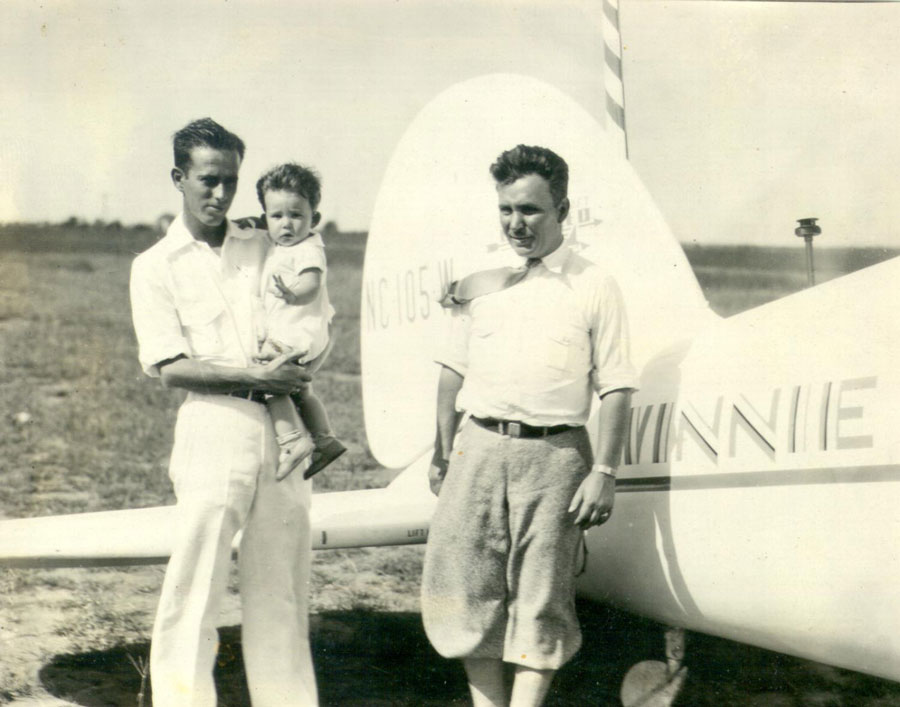
The Encyclopedia of Oklahoma History and Culture
POST, WILEY HARDEMAN (1898–1935).
On November 22, 1898, Mae Post gave birth to a boy near the small farming community of Corinth, Texas. Mae and her husband, William Francis Post, named the infant Wiley Hardeman. He was one of five children born to the small-time cotton farmers. As a young boy Wiley Post never enjoyed farming. His dislike of the family business was coupled with problems in elementary school. Post was more inclined to play with friends than to study or complete his homework. Despite academic troubles he graduated from elementary school after completing the seventh grade. Throughout his adolescence Wiley Post's family moved several times to small towns throughout Texas and Oklahoma. By 1920 his parents settled on a farm near Maysville, Oklahoma, forty-five miles south of Oklahoma City.
In 1913 at the county fair in Lawton, Oklahoma, Wiley Post saw his first airplane in flight. Watching a Curtiss "pusher" fly that day changed his life. He enrolled in the Sweeney Automobile and Aviation School in Kansas City. He excelled in the science and math classes that were taught at the trade school. After completing a seven-month program, he graduated, returned to Oklahoma, and worked for the Chickasaw and Lawton Construction Company.
During World War I Wiley Post was eager to become a pilot in the U.S. Army Air Service (USAS). He entered the Students' Army Training Camp located at the University of Oklahoma. While living in Norman, he was assigned to the Students' Army Training Camp Section B to learn the fundamentals of radio technology. However, he did not enter the USAS, because Germany surrendered. Once again, Wiley Post was out of work.
After the war Post found work as a "roughneck" in the Oklahoma oil fields. Despite having employment he was at a personal crossroads. This period of his life has been difficult to explain, because sources are unavailable. According to a recent biography entitled Forgotten Eagle: Wiley Post, America's Heroic Aviation Pioneer, the flyer had more than just academic problems. In 1921 he was arrested for armed robbery. Serving more than a year in the Oklahoma State Reformatory, he was paroled in the summer of 1922.
After his brief stint in jail Post returned to the oil fields. He augmented his income by working for Burrell Tibbs's Flying Circus. He started out as a parachute jumper. Later he learned how to fly. In October 1926 he was injured in an accident on an oil rig when a piece of metal struck him in the left eye. The resulting infection blinded the injured eye, which he covered with a patch, an item that would become world famous in the next decade. Partial loss of vision did not prevent him from flying.
With money from the accident settlement Wiley Post bought a Canadian-built JN-4 "Canuck." In June 1927 he married Edna Mae Laine. After damaging the Canuck, he sold the aircraft. Post was then hired as the pilot for oilman Florence C. Hall. In 1928 Hall bought a Lockheed Vega and christened the aircraft the Winnie Mae, after his daughter. Eventually, in 1930 he purchased a second Vega and also named it Winnie Mae.
Wiley Post's rise to fame began in 1930 when he won an air race between Chicago and Los Angeles. In 1931 he and navigator Harold Gatty flew around the top of the world in the Winnie Mae from New York City to New York City in less than nine days. His first trip was chronicled in the book Around the World in Eight Days: The Flight of the Winnie Mae (1931).
In 1933 Post shattered his around-the-world record with a time of seven days, eighteen hours, and forty-nine minutes. After his record-breaking flights he experimented with high-altitude flying. Because the Winnie Mae was not pressurized, he designed a pressure suit, with technical assistance from B. F. Goodrich Company. His experimental flights ultimately proved the value of using the east-to-west jet stream. Post's pressure suit was a predecessor for the test pilots' and astronauts' pressure suits used in the 1950s and 1960s.
In 1935 Wiley Post constructed a hybrid floatplane from a Lockheed Orion. He wanted to test the operational capabilities of the aircraft with a long-distance flight. He asked friend and humorist Will Rogers to join him on a junket to Alaska and Siberia. Unfortunately, the hybrid Orion proved to be aerodynamically unstable. Shortly after takeoff in the fog on August 15, 1935, Post lost control of the aircraft. It crashed into the Walakpa Lagoon near Point Barrow, Alaska, killing both Post and Rogers. Wiley Post's remains were transported to Oklahoma for burial.
Upon its arrival in Oklahoma City Post's body lay in state in the Rotunda of the Capitol. Hundreds of friends and fans around the world sent flowers to honor his brief life. More than fifteen thousand visitors viewed his bronze coffin. A funeral service was held at the First Baptist Church in Oklahoma City. His remains were interred at the Memorial Park Cemetery in Edmond, Oklahoma.
Throughout the American Southwest, hangars, aeronautical schools, and airports have been named for Wiley Post. In 1979 the U.S. Post Office issued a stamp in his honor. The Winnie Mae is displayed in the Smithsonian's National Air and Space Museum's Steven F. Udvar-Hazy Center near Washington's Dulles International Airport (a full-size replica is displayed in the Oklahoma History Center building in Oklahoma City). Post's brief but remarkable flying career had a tremendous impact on the early aviation industry. His adventurism, his record-setting flights, and his aeronautical experiments transformed aviation and blazed a pathway for modern flight in the post–1945 period.
See Also
AIRPORTS, GERALDYN M. COBB, ROY ORLANDO HUNT, JACKIE LINWOOD RIDLEY, TRANSPORTATION, WINNIE MAE







